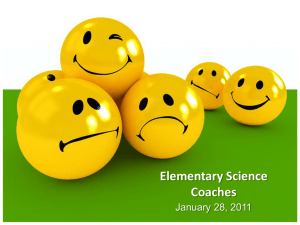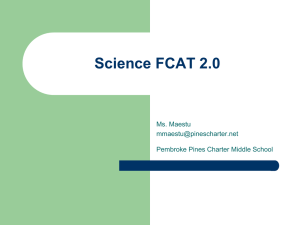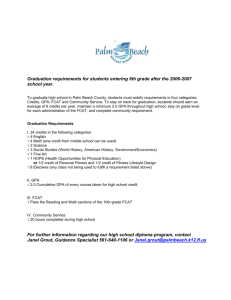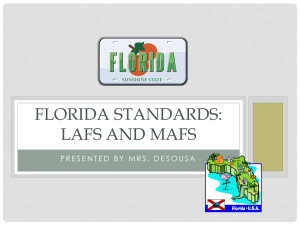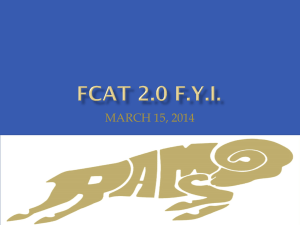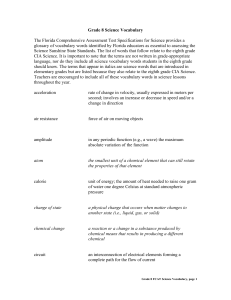NGSSS & FCAT 2.0 for 6-8 Science
advertisement
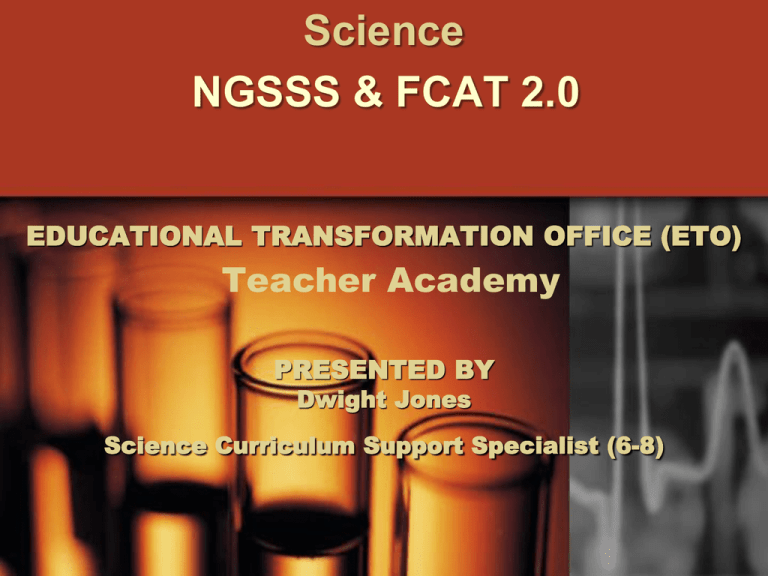
Science NGSSS & FCAT 2.0 EDUCATIONAL TRANSFORMATION OFFICE (ETO) Teacher Academy PRESENTED BY Dwight Jones Science Curriculum Support Specialist (6-8) ICE BREAKER ACTIVITY Getting Acquainted “These Are A Few Of My Favorite Things” Please share your… – Name – School – Subject/Grade you teach or Job Title – Complete this sentence: These are a few of my favorite things.. Science Lab Activity, why?……. Science Lesson,……why. 3 Common Board Configuration (CBC) DATE: August 09, 2011 BELL RINGER: Using a circle map, list as many words as you can associated with FCAT 2.0 BENCHMARK: FCAT 2.0.2011 OBJECTIVE: Today we will examine the role FCAT 8th Grade Science Specifications play in our work to improve student achievement by using item specifications and Webb’s DOK to critique the level of complexity among questions provided in cooperative groups. ESSENTIAL QUESTION: How can understanding the FCAT 2.0 Item Specification Document impact teaching and increase student achievement? VOCABULARY: FCAT 2.0, Cognitive Complexity, Item Specifications, Low Complexity, Moderate Complexity, High Complexity, NGSSS AGENDA: •Access prior knowledge: Student discussion on Circle Map •Fixing Failing Grades Video I Do: •NGSSS Overview •FCAT 2.0 Overview •Processing Time: Think-Pair-Share •Item Specs •Processing Time: Revisit Circle Map •Bloom vs. Webb •Analyze Cognitive Complexities •Lesson Review and Resources •Revisit Essential Question •Exit Slip: 3-2-1 Post-It •Homework Instruction EXIT SLIP: On a post-it slip, Connect: 3 ways item specifications can help you impact student achievement . Connect : 2 things you now know about cognitive complexity. Connect: 1 question you still have about FCAT 2.0. HOME LEARNING: Review today’s lesson and develop your next steps to share this information with teachers at your school BELL RINGER FCAT 2.0 1.Draw the Circle Map shown here. 2.Write “FCAT 2.0” in the inner circle. 3.In the outer circle write all the words associated with “FCAT 2.0” that comes to mind Why change the current standards? Identify some reasons why the Science Standards were changed… 1 2 3 Three Reasons Why The Standards were Changed • Low student performance • Persistent low achievement gaps • Lack of student preparation Recent NAEP data reveal that while our 4th grade students barely surpassed the national average, our 8th grade students lagged behind. 152 148 144 140 136 132 128 124 120 116 112 108 104 100 4th grade 8th grade FL US Florida’s 8th graders generally performed below the national average on the 2005 NAEP, although our Hispanic students fared better than the national average for Hispanics. 2005 NAEP 8th grade Scale Scores, Fl. vs. U.S. 160 147 141 140 123 Scale Scores 120 127 131 118 100 U.S. 80 Fl. 60 40 20 0 All Students Black Hispanic In the 2005 “The State of Science Standards Report” done by the Fordham Institute awarded Florida’s Science Standards a “F” grade and Massachusetts received an “A”. Gross, et al, (2005) Reasons why Fordham Gave Florida A Grade of “F” • Florida’s standards were lacking in content • Florida lags behind other states and other nations • Florida had no criteria to understand and analyze the impact of scientific discoveries • Chemistry content in K-8 is scanty, and even less is required in K-12 • Physics is disappointing, due to a prevalence of errors in fact and presentation Science Standards In The USA Needs Coherence, Focus, and Rigor The report states Coherence, Focus, and Rigor all need immediate attention in Science. You are the Coach/Teacher in your school: QUESTION: Based on what you know about Coherence, Focus, and Rigor Describe what you should expect to see different when you look at 1. Coherence 2. Focus 3. Rigor In your science classes Science Standards In The USA Needs Coherence, Focus, and Rigor Coherence – Is the sequence of how the topics are taught. (Schmidt, et al., 2005 p. 528) Focus - The standards must emphasize central concepts, laws, principles, theories, and inquiry strategies (Slattery, 2007) Rigor - The standards must progress in terms of depth (cognitive complexity) as students move from one grade level to the next? (Schmidt, et al., 2005) Recommendations Identify a big idea and describe the most important characteristics. Identify essential core content for each area – Example: Earth and Space Science, and connect it to one or two of the most closely related big ideas. Know where key concepts can be best taught Address common misconceptions and monitor student’s understanding. Focus on learning progressions, cycling back through core ideas in different contexts. (Jean Slattery Achieve Inc., The American Diploma Project. 2007) Recommendations From the National Science Education Standards Construct grade level specific benchmarks for K-8 that will support the Bodies of Knowledge. Verify that the standards are clearly written. Check the progression of concepts and skills across grades Check for the omission of benchmarks in the new standards. Check the content expectations for each grade level Ensure topics are clustered to facilitate connections and promotes powerful, teaching units. (Jean Slattery Achieve Inc., The American Diploma Project. 2007) The State of Florida Commitment to Excellence In 2006, the Florida legislature stated its commitment to higher and more challenging standards for Florida’s children by passing HB 7087. Florida law now reads: §1001.03(1) ...The state board shall establish a schedule to facilitate the periodic review of the standards to ensure adequate rigor, relevance, logical student progression, and integration of reading, writing, and mathematics across all subject areas. SUNSHINE STATE STANDARDS Demand for Critical Thinkers The benchmarks in the Sunshine State Standards (SSS) identify knowledge and skills students are expected to acquire at each grade level, with the underlying expectation that students also demonstrate critical thinking. Goal 3, Standard 4, of Florida’s System of School Improvement and Accountability makes this expectation clear: Florida students use creative thinking skills to generate new ideas, make the best decisions, recognize and solve problems through reasoning, interpret symbolic data, and develop efficient techniques for lifelong learning. New Standards Outcome Goals • Increase depth, understanding, process skills, proficiency • Lead to mastery of concepts and skills covering understanding Science Standards No longer a mile wide and an inch deep! • Old K-8 Standards had an average of 67.4 Grade Level Expectations per grade level • The new K-8 Standards (NGSSS) have an average of only 29 benchmarks per grade level • Standards within each high school Course Description now provide the teacher with specific standards to teach 19 Compare the Old Standards with the New Standards OLD STANDARDS NEW STANDARDS New Sunshine State Standards vs. 1996 Sunshine State Standards? Old Standards (Strands) The Nature of Matter Energy Force and Motion Processes That Shape the Earth Earth and Space Processes of Life How Living Things Interact With Their Environment Nature of Science New Standards (Bodies of Knowledge) E - Earth and Space Science L - Life Science P - Physical Science N - Nature of Science How Do I Read The New FCAT 2.0 Coding Scheme? 22 Benchmark Coding Scheme The numbering for the big ideas is consistent throughout the document. Not all big ideas are addressed at each grade level, so the numbering scheme is not consecutive for each grade level. SC. 5. N. 1. 1 Subject Grade Level Body of Knowledge Big Idea Benchmark Body of Knowledge Key: N ~ Nature of Science E ~ Earth and Space Science P ~ Physical Science L ~ Life Science FCAT 2.0 New Course Description • Includes benchmarks specifically identified for each course and benchmarks from cross content areas (These benchmarks are usually listed at the beginning of each course description.) • States the cognitive complexity expectation for each benchmark • Defines vocabulary in each benchmark • Provides additional expected vocabulary that should be included by course 24 The Importance of Your SCIENCE FCAT ITEM SPECIFICATIONS • What are some of the things your Science Item Specifications covers? 1. 2. 3. 4. 5. 6. The Importance of THE SCIENCE FCAT ITEM SPECIFICATIONS What are some of the things your Science Item Specifications covers? 1. Defines the content and format of the test items 2. Alignment of items with the standards 3. Provides information about the scope and function of the FCAT 4. It provides general and grade-specific guidelines 5. Describes how the science benchmarks are assessed on the FCAT 2.0 6. Provides sample test items 7. Provides a range of difficulty and cognitive complexity Where can I find FCAT Item Specifications for FCAT II Science? • Test Item Specifications may be found at www.fldoe.org • Item Specifications is available for Grades 5, 8, and the Biology EOC (3 separate documents) 27 FCAT 2.0 ITEM SPECIFICATIONS Was developed and approved by Committees of experienced Florida Educators •The Specifications is a resource document that defines the content and format of the test and test items •Each grade-level Specifications document indicates the alignment of items with the Standards. •It provides information about the scope and function of the FCAT. •It provide general and grade-specific guidelines for the development of all test items used in the FCAT Science test . FCAT 2.0 Item Specifications • Describe how the science benchmarks are assessed on the FCAT 2.0. • Each grade level includes benchmarks from the four Bodies of Knowledge (Nature of Science, Life Science, Earth Science, and Physical Science). • 18 Big Ideas thread throughout all the grade levels and build in rigor and depth as students advance. • The sample test items included in the Specifications represent, whenever possible, a range of difficulty and cognitive complexity. • Although most of the test items are of average difficulty and moderate complexity, some of the test items presented will be challenging for some students and are specifically included to prompt item writers to submit test items that will measure the abilities of higher-achieving students. Next Generation Assessment Transition: 2009-2013 Year Administered to Students Type of Assessment Assessment Area 2010-11 2011-12 2012-13 2013-14 FCAT FCAT Writing Gr 4, 8, 10 Gr 4, 8, 10 Gr 4, 8, 10 Gr 4, 8, 10 FCAT Science Gr 5, 8, 11 FCAT Reading FCAT 2.0 FCAT Mathematics Gr 10 FCAT 2.0 Reading FCAT 2.0 Mathematics Gr 3-10 Gr 3-10 Gr 3-10 Gr 3-10 Gr 3-8 Gr 3-8 Gr 3-8 Gr 3-8 Gr 5, 8 Gr 5, 8 Gr 5, 8 High School High School High School High School High School High School High School High School High School High School High School FCAT 2.0 Science End-of-Course Algebra 1 Assessments Geometry Biology 1 US History Civics High School Middle School Will our assessments be different? YES! • Sept, 2007 New Standards were adopted • 2007-08 Writing teams met to develop FCAT Test Item Specifications • 2008-09 Test items were developed and reviewed by multiple committees • 2009-10 Test items were Field Tested along with old standards testing • 2010-11 NEW 3rd-11th FCAT and Biology31 EOC Field test FCAT 2.0 Grade 8 • Comprehensive assessment • Grade 8 test will cover benchmarks from grades 6-8 • Multiple-choice items only • Reference sheets - not needed • Periodic Table available for grade 8 Processing Moment Think – Pair – Share (TPS) 1. Think about the information provided so far. 2. Pair up with someone 3. Share with your partner something NEW you’ve learned. CRITERIA FOR FCAT 2.0 SCIENCE TEST ITEMS All FCAT 2.0 Science test items are in multiple-choice (MC) format. The general specifications on pages 5 through 16 cover the following criteria for the FCAT 2.0: •Use of Graphics •Item Style and Format •Scope of Test Items •Guidelines for Item Writers •Cognitive Complexity of FCAT 2.0 Science Test Items •Universal Design NGSSS Across the Grades The Big Idea and/or Standard 1: The Practice of Science 2: Characteristics of Scientific Knowledge 3: The Role of Theories, Laws, Hypotheses, and Models 4: Science and Society 5: Earth in Space in Time 6: Earth Structures 7: Earth Systems and Patterns 8: Properties of Matter 9: Changes in Matter 10: Forms of Energy 11: Energy Transfer and Transformations 12: Motion of Objects 13: Forces and Changes in Motion 14: Organization and Development of Living Organisms 15: Diversity and Evolution of Living Organisms 16: Heredity and Reproduction 17: Interdependence 18: Matter and Energy Transformations Elementary Middle High School Grades Grades Grades K 1 2 3 4 5 6 7 8 9 10 11 12 37 Crosswalk between FCAT assessed benchmarks from the 1996 Sunshine State Science Standards and the New Science Standards Grades 6-8 SC.A.1.3.1: AA (Also assesses A.1.3.2 & A.1.3.6) The student identifies various ways in which substances differ (e.g., mass, volume, shape, density, texture, and reaction to temperature and light). MC,GR,SR BM CODE SC.8.P.8.3 Current SSS Benchmark Explore and describe the densities of various materials through measurement of their masses Strength of correlation M and volumes. SC.8.P.8.4 S Classify and compare substances on the basis of characteristic physical properties that can be demonstrated or measured; for example, density, thermal or electrical conductivity, solubility, magnetic properties, melting and boiling points, and know that these properties are independent of the amount of the sample. SC.A.1.3.2: AA (Assessed as A.1.3.1) The student understands the difference between weight and mass. MC,GR,SR SC.8.P.8.2 S Differentiate between weight and mass recognizing that weight is the amount of gravitational pull on an object and is distinct from, though proportional to, mass. SC.A.1.3.3: CS The student knows that temperature measures the average energy of motion of the particles that make up the substance. MC Temperature is not specifically defined until grades 9-12 in the new standards. SC.A.1.3.4: CS The student knows that atoms in solids are close together and do not move around easily; in liquids, atoms tend to move farther apart; in gas, atoms are quite far apart and move around freely. MC SC.8.P.8.1 S Explore the scientific theory of atoms (also known as atomic theory) by using models to explain the motion of particles in solids, liquids, and gases. Science Crosswalk http://www.fldoestem.org/Uploads/1/docs/FLDOE/K-12%20crosswalk_draft3%20(2).pdf 38 Processing Moment FCAT 2.0 Turn and Talk with a shoulder buddy and add something NEW that you have learned to your outer circle. FCAT Science 2.0 Here is the new breakdown, based on Webb’s DOK: Note: A high complexity question in 5th grade may not be a high complexity question in 8th grade. The complexity is ultimately based on the cognitive demand placed on the student. Cognitive complexity also may depend on the level of the distracter. FCAT 2.0 Science Test Items The degree of challenge of FCAT 2.0 items is currently categorized in two ways: item difficulty and cognitive complexity. Item Difficulty Cognitive Complexity • Easy: More than 70% of students are more likely to respond correctly. • Average: Between 40-70% are more likely to respond correctly. • Challenging: Less than 40% are likely to respond correctly. • The rationale for classifying an item by its DOK level of complexity focuses on the expectations made of the item, not on the ability of the student. • The categories—low complexity, moderate complexity, and high complexity—form an ordered description of the demands a test item may make on a student LEVELS OF COMPLEXITY Low Moderate High Levels of Complexity Moderate Complexity Science moderateHigh Complexity complexity test items Low Complexity Science high-complexity involve more flexible Science low-complexity test thinking than low-complexity test items make heavy items rely heavily on the test items do. They require demands on student recall and recognition of a response that goes thinking. Students must previously learned concepts beyond the habitual, is not engage in abstract and principles. Test items specified, and ordinarily reasoning, planning, typically specify what the involves more than a single student is to do, which often analysis, judgment, and step or thought process. is to carry out some creative thought. The The student is expected to procedure that can be test items require that decide what to do—using performed mechanically. It the student think in an informal methods of is not left to the student to reasoning and problemabstract and come up with an original solving strategies—and to sophisticated way, often method or solution. bring together skill and involving multiple steps. knowledge from various domains How is Webb’s Depth of Knowledge Different from Bloom’s Taxonomy? BLOOMS vs. WEBB Make a Chart comparing BLOOMS vs WEBBs BLOOM’S 1. WEBB’S 1. 2. 3. 2. 4. 3. 5. 4. 45 BLOOMS vs. WEBB Make a Chart comparing BLOOMS vs WEBBs BLOOM’S 1. Knowledge: Recall 2. Comprehension: Ability to process 3. Application WEBB’S 1. Knowledge: Recall of Facts, Information, Procedure 4. Analysis 2. Basic Application of Skills Concept 3. Strategic Thinking 5. Synthesis & Evaluation 4. Extended Thinking 46 Bloom VS. Webb Bloom VS. Webb Complexity v. Difficulty The FCAT items degree of challenge are currently categorized in two ways: 1. Cognitive Complexity • Determined by what the item requires the student to recall, understand, analyze, and do. • Assume student is familiar with basic concepts of the task and focuses on the task. • Depends on the task not the student. 2. Item Difficulty • Depends on the percentage of students likely to answer correctly. – Easy – More than 70% – Average – 40% to 70% – Challenging – Less than 40% 49 STUDENT LEVELS Question: When we talk about a student’s cognitive complexity levels, what are we really saying? Answer: 50 Levels of Cognitive Complexity • Levels 1, 2, 3, and 4 refer to cognitive processes involved in completing a task or an assessment item • Cognitive Complexity Levels 1, 2, 3, and 4 were originally developed to rate assessment items • They are also used to rate FCAT standards • Florida used Webb’s DOK/Cognitive Complexity Levels to align the cognitive demands of SSS to FCAT test items • Cognitive Complexity/DOK ratings create a “ceiling” to assess each benchmark 51 Levels of Cognitive Complexity THE 3 LEVELS Of COGNITIVE COMPLEXITY • Low Complexity – Recall and recognition • Moderate Complexity – Flexible thinking and choice • High Complexity – Abstract reasoning and planning 52 Low Complexity DOK Level 1 • Skills required to respond to low complexity items include – solving a one-step problem; – computing a sum, difference, product, or quotient; – evaluating a variable expression, given specific values for the variables; – recognizing or constructing an equivalent representation; – recalling or recognizing a fact, term, or property; – retrieving information from a graph, table, or figure; – identifying appropriate units or tools for common measurements; – performing a single-unit conversion; – reproducing a diagram or standard representation; – completing a routine procedure, such as measure temperature; and 53 – calculating using a common formula. Moderate Complexity DOK Level 2 • Skills required to respond to moderate complexity items involve – more flexible thinking. – involves more than a single step or thought process. – deciding what to do—using informal methods of reasoning and problem-solving – requires a response that goes beyond the habitual, is not specified, and ordinarily The student is expected to decide what to do— – bringing together skill and knowledge from various domains – develop logical arguments – explain terms and concepts 54 High Complexity DOK Level 3 • Skills required to respond correctly to high complexity items include – performing a procedure having multiple steps and multiple decision points; – solving a non-routine problem (as determined by grade-level appropriateness); – solving a problem in more than one way; – describing how different representations can be used for different purposes; – generalizing an algebraic or geometric pattern; – explaining and justifying a solution to a problem; – describing, comparing, and contrasting solution methods; – providing a mathematical justification; – analyzing similarities and differences between procedures and concepts; – formulating an original problem, given a situation; – formulating a mathematical model for a complex situation; – analyzing or producing a deductive argument; – identifying research questions and design experiments 55 – developing a scientific model for a complex situation; and – forming conclusions and generalizations from experimental data. Benchmark Number: SC.8.E.5.4 Benchmark Description: Explore the Law of Universal Gravitation by explaining the role that gravity plays in the formation of planets, stars, and solar systems and in determining their motions. Subject Area: Science Grade Level: 8 BODY OF KNOWLEDGE: Earth and Space Science Big Idea: Earth in Space and Time - The origin and eventual fate of the Universe still remains one of the greatest questions in science. Gravity and energy influence the formation of galaxies, including our own Milky Way Galaxy, stars, the planetary systems, and Earth. Humankind’s need to explore continues to lead to the development of knowledge and understanding of the nature of the Universe. Date Adopted or Revised: 02/08 Date of Last Rating: 05/08 Cognitive Complexity/Depth of Knowledge Rating: High - What does this mean? 56 Let’s Investigate Low? Medium? High? Recall/recognize which force causes objects to move down an inclined plane. What is the student expected to know? Low? Medium? High? Identify/Explain forces Acting upon objects (friction and gravity); Compare/contrast materials according to properties, and make connections. What is the student expected to know? Low? Medium? High? Recognize and explain: all components of a scientific investigation, that explanations must be linked to evidence, and link them to knowledge of Forces and Changes in Motion. What is the student expected to know? Pondering Moment • If 10-20% of the questions on the FCAT are of Low level complexity… How much time should we devote to DOK level 1 Thinking? • If 80% of the questions on the FCAT require Moderate to High levels of complexity… What are YOU doing to promote these complex levels of higher order thinking? Should Science Support READING? BIOLOGY I COURSE DESCRIPTION: LA.910.2.2.3 The student will organize information to show understanding or relationships among facts, ideas, and events (e.g., representing key points within text through charting, mapping, paraphrasing, summarizing, comparing, contrasting, or outlining); LA.910.4.2.2 The student will record information and ideas from primary and/or secondary sources accurately and coherently, noting the validity and reliability of these sources and attributing sources of information; Language Arts standards are infused in all courses. 62 How Can I Ensure Success In FCAT 2.0 ? List some ways How Can I Ensure Success In FCAT 2.0 •Know your Course Standards •Understand Webb’s Cognitive Complexity •Study Item Specifications for appropriate rigor •Teach explicitly and systematically •Use the Gradual Release Model (I-WE-YOU) •Plan relevant lessons with Essential Questions •Write Measurable Objectives Why will it be important to align existing resources (textbooks, etc.) to the new standards? • Discussion 65 How can I REALLY understand the “Depth” of the Benchmarks? • The Resources – that will help teachers gain a better understanding of the benchmarks are available at www.floridastandards.org www.cpalms.org • Professional development, PLCs, Lesson Study and team planning will support teachers as they transition to the NGSSS • What role should my textbook play? A resource 66 Where can I find Help and/or Assistance • K-12 course descriptions on the DOE Website http://floridastandards.org/Courses/CourseDescription Search.aspx • “Remarks” are included with each benchmark. • These examples may be helpful in providing useful information about the level of rigor expected 67 Resources Standards: http://www.floridastandards.org/Standards/FLStand ardSearch.aspx Item Specifications: http://www.floridastandards.org/Resource/FCAT_It em_Specifications.aspx Course Descriptions: http://www.floridastandards.org/Courses/CourseDe scriptionSearch.aspx FCAT 2.0: http://fcat.fldoe.org/fcat2/ Essential Question EXIT SLIP It Was Truly A Pleasure THE END

